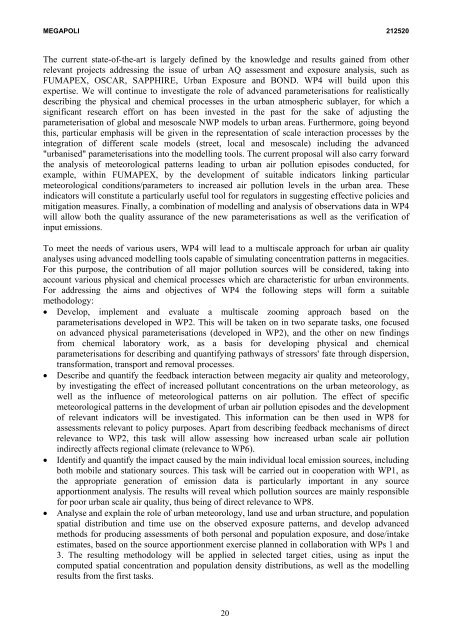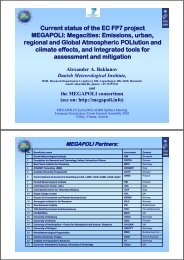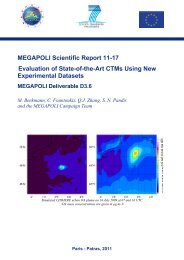D E S C R I P T I O N O F W O R K - MEGAPOLI - Dmi
D E S C R I P T I O N O F W O R K - MEGAPOLI - Dmi
D E S C R I P T I O N O F W O R K - MEGAPOLI - Dmi
Create successful ePaper yourself
Turn your PDF publications into a flip-book with our unique Google optimized e-Paper software.
<strong>MEGAPOLI</strong> 212520<br />
The current state-of-the-art is largely defined by the knowledge and results gained from other<br />
relevant projects addressing the issue of urban AQ assessment and exposure analysis, such as<br />
FUMAPEX, OSCAR, SAPPHIRE, Urban Exposure and BOND. WP4 will build upon this<br />
expertise. We will continue to investigate the role of advanced parameterisations for realistically<br />
describing the physical and chemical processes in the urban atmospheric sublayer, for which a<br />
significant research effort on has been invested in the past for the sake of adjusting the<br />
parameterisation of global and mesoscale NWP models to urban areas. Furthermore, going beyond<br />
this, particular emphasis will be given in the representation of scale interaction processes by the<br />
integration of different scale models (street, local and mesoscale) including the advanced<br />
"urbanised" parameterisations into the modelling tools. The current proposal will also carry forward<br />
the analysis of meteorological patterns leading to urban air pollution episodes conducted, for<br />
example, within FUMAPEX, by the development of suitable indicators linking particular<br />
meteorological conditions/parameters to increased air pollution levels in the urban area. These<br />
indicators will constitute a particularly useful tool for regulators in suggesting effective policies and<br />
mitigation measures. Finally, a combination of modelling and analysis of observations data in WP4<br />
will allow both the quality assurance of the new parameterisations as well as the verification of<br />
input emissions.<br />
To meet the needs of various users, WP4 will lead to a multiscale approach for urban air quality<br />
analyses using advanced modelling tools capable of simulating concentration patterns in megacities.<br />
For this purpose, the contribution of all major pollution sources will be considered, taking into<br />
account various physical and chemical processes which are characteristic for urban environments.<br />
For addressing the aims and objectives of WP4 the following steps will form a suitable<br />
methodology:<br />
• Develop, implement and evaluate a multiscale zooming approach based on the<br />
parameterisations developed in WP2. This will be taken on in two separate tasks, one focused<br />
on advanced physical parameterisations (developed in WP2), and the other on new findings<br />
from chemical laboratory work, as a basis for developing physical and chemical<br />
parameterisations for describing and quantifying pathways of stressors' fate through dispersion,<br />
transformation, transport and removal processes.<br />
• Describe and quantify the feedback interaction between megacity air quality and meteorology,<br />
by investigating the effect of increased pollutant concentrations on the urban meteorology, as<br />
well as the influence of meteorological patterns on air pollution. The effect of specific<br />
meteorological patterns in the development of urban air pollution episodes and the development<br />
of relevant indicators will be investigated. This information can be then used in WP8 for<br />
assessments relevant to policy purposes. Apart from describing feedback mechanisms of direct<br />
relevance to WP2, this task will allow assessing how increased urban scale air pollution<br />
indirectly affects regional climate (relevance to WP6).<br />
• Identify and quantify the impact caused by the main individual local emission sources, including<br />
both mobile and stationary sources. This task will be carried out in cooperation with WP1, as<br />
the appropriate generation of emission data is particularly important in any source<br />
apportionment analysis. The results will reveal which pollution sources are mainly responsible<br />
for poor urban scale air quality, thus being of direct relevance to WP8.<br />
• Analyse and explain the role of urban meteorology, land use and urban structure, and population<br />
spatial distribution and time use on the observed exposure patterns, and develop advanced<br />
methods for producing assessments of both personal and population exposure, and dose/intake<br />
estimates, based on the source apportionment exercise planned in collaboration with WPs 1 and<br />
3. The resulting methodology will be applied in selected target cities, using as input the<br />
computed spatial concentration and population density distributions, as well as the modelling<br />
results from the first tasks.<br />
20




